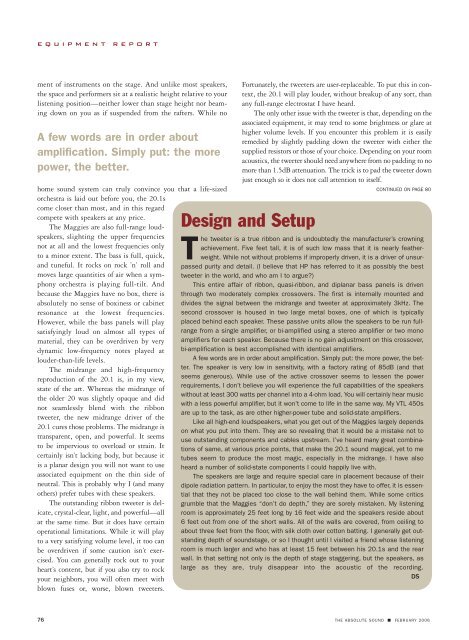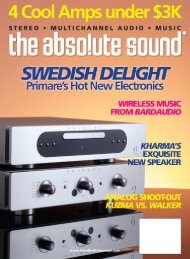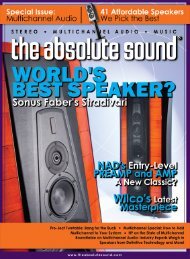The Cutting Edge
The Cutting Edge
The Cutting Edge
- No tags were found...
Create successful ePaper yourself
Turn your PDF publications into a flip-book with our unique Google optimized e-Paper software.
equipmentreportment of instruments on the stage. And unlike most speakers,the space and performers sit at a realistic height relative to yourlistening position—neither lower than stage height nor beamingdown on you as if suspended from the rafters. While noA few words are in order aboutamplification. Simply put: the morepower, the better.home sound system can truly convince you that a life-sizedorchestra is laid out before you, the 20.1scome closer than most, and in this regardcompete with speakers at any price.<strong>The</strong> Maggies are also full-range loudspeakers,slighting the upper frequenciesnot at all and the lowest frequencies onlyto a minor extent. <strong>The</strong> bass is full, quick,and tuneful. It rocks on rock ’n’ roll andmoves large quantities of air when a symphonyorchestra is playing full-tilt. Andbecause the Maggies have no box, there isabsolutely no sense of boxiness or cabinetresonance at the lowest frequencies.However, while the bass panels will playsatisfyingly loud on almost all types ofmaterial, they can be overdriven by verydynamic low-frequency notes played atlouder-than-life levels.<strong>The</strong> midrange and high-frequencyreproduction of the 20.1 is, in my view,state of the art. Whereas the midrange ofthe older 20 was slightly opaque and didnot seamlessly blend with the ribbontweeter, the new midrange driver of the20.1 cures those problems. <strong>The</strong> midrange istransparent, open, and powerful. It seemsto be impervious to overload or strain. Itcertainly isn’t lacking body, but because itis a planar design you will not want to useassociated equipment on the thin side ofneutral. This is probably why I (and manyothers) prefer tubes with these speakers.<strong>The</strong> outstanding ribbon tweeter is delicate,crystal-clear, light, and powerful—allat the same time. But it does have certainoperational limitations. While it will playto a very satisfying volume level, it too canbe overdriven if some caution isn’t exercised.You can generally rock out to yourheart’s content, but if you also try to rockyour neighbors, you will often meet withblown fuses or, worse, blown tweeters.Fortunately, the tweeters are user-replaceable. To put this in context,the 20.1 will play louder, without breakup of any sort, thanany full-range electrostat I have heard.<strong>The</strong> only other issue with the tweeter is that, depending on theassociated equipment, it may tend to some brightness or glare athigher volume levels. If you encounter this problem it is easilyremedied by slightly padding down the tweeter with either thesupplied resistors or those of your choice. Depending on your roomacoustics, the tweeter should need anywhere from no padding to nomore than 1.5dB attenuation. <strong>The</strong> trick is to pad the tweeter downjust enough so it does not call attention to itself.Design and SetupCONTINUED ON PAGE 80<strong>The</strong> tweeter is a true ribbon and is undoubtedly the manufacturer’s crowningachievement. Five feet tall, it is of such low mass that it is nearly featherweight.While not without problems if improperly driven, it is a driver of unsurpassedpurity and detail. (I believe that HP has referred to it as possibly the besttweeter in the world, and who am I to argue?)This entire affair of ribbon, quasi-ribbon, and diplanar bass panels is driventhrough two moderately complex crossovers. <strong>The</strong> first is internally mounted anddivides the signal between the midrange and tweeter at approximately 3kHz. <strong>The</strong>second crossover is housed in two large metal boxes, one of which is typicallyplaced behind each speaker. <strong>The</strong>se passive units allow the speakers to be run fullrangefrom a single amplifier, or bi-amplified using a stereo amplifier or two monoamplifiers for each speaker. Because there is no gain adjustment on this crossover,bi-amplification is best accomplished with identical amplifiers.A few words are in order about amplification. Simply put: the more power, the better.<strong>The</strong> speaker is very low in sensitivity, with a factory rating of 85dB (and thatseems generous). While use of the active crossover seems to lessen the powerrequirements, I don’t believe you will experience the full capabilities of the speakerswithout at least 300 watts per channel into a 4-ohm load. You will certainly hear musicwith a less powerful amplifier, but it won’t come to life in the same way. My VTL 450sare up to the task, as are other higher-power tube and solid-state amplifiers.Like all high-end loudspeakers, what you get out of the Maggies largely dependson what you put into them. <strong>The</strong>y are so revealing that it would be a mistake not touse outstanding components and cables upstream. I’ve heard many great combinationsof same, at various price points, that make the 20.1 sound magical, yet to metubes seem to produce the most magic, especially in the midrange. I have alsoheard a number of solid-state components I could happily live with.<strong>The</strong> speakers are large and require special care in placement because of theirdipole radiation pattern. In particular, to enjoy the most they have to offer, it is essentialthat they not be placed too close to the wall behind them. While some criticsgrumble that the Maggies “don’t do depth,” they are sorely mistaken. My listeningroom is approximately 25 feet long by 16 feet wide and the speakers reside about6 feet out from one of the short walls. All of the walls are covered, from ceiling toabout three feet from the floor, with silk cloth over cotton batting. I generally get outstandingdepth of soundstage, or so I thought until I visited a friend whose listeningroom is much larger and who has at least 15 feet between his 20.1s and the rearwall. In that setting not only is the depth of stage staggering, but the speakers, aslarge as they are, truly disappear into the acoustic of the recording.DS76 THE ABSOLUTE SOUND ■ FEBRUARY 2006










